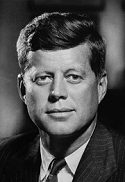John F. Kennedy

John F. Kennedy
35th President
(1961-1963) |
| Order: |
35th President |
| Term of Office: |
January 20, 1961 - November 22, 1963 |
| Followed: |
Dwight D. Eisenhower |
| Succeeded by: |
Lyndon Johnson |
| Date of Birth |
Tuesday, May 29, 1917 |
| Place of Birth: |
Brookline, Massachusetts |
| Date of Death: |
Friday, November 22, 1963 |
| Place of Death: |
Dallas, Texas |
| First Lady: |
Jacqueline Lee Bouvier |
| Profession: |
politician |
| Political Party: |
Democrat |
| Vice President: |
Lyndon Johnson |
|
John Fitzgerald Kennedy (May 29, 1917 - November 22, 1963), often
referred to as JFK, was the 35th (1961-1963) President of the United
States.
Kennedy was the youngest person so far to be elected U.S. president
(although Theodore Roosevelt was some months younger when he became president
upon William McKinley's death), and the first (and as yet only) Roman Catholic
president. He beat Richard Nixon, Vice President in the previous administration,
in a famous, closely-contested presidential election in 1960. Theodore
H. White's 1961 book about that election campaign, The Making of the
President 1960, was not only a national best-seller but was also used
as a supplementary text in high school and college courses in U. S. government
and history.
For various reasons, Kennedy was, during the time he served, perhaps
the most popular president in U.S. history. He was a handsome, photogenic
man who seemed open and accessible, and his administration marked a notable
increase in direct media exposure of the president to the public at large,
through television broadcasts from the Oval Office, televised press conferences,
and numerous photo spreads in popular magazines. The "charisma" Kennedy
and his family projected led to the figurative designation of "Camelot"
for his administration. His glamorous wife "Jackie" was as newsworthy as
he was, and the way they handled personal tragedies, especially the death
of their newborn son Patrick Bouvier Kennedy in August 1963, enhanced their
public image.
The house where Kennedy was born in Brookline (in the Boston, Massachusetts,
metropolitan area) is now a National Historic Site, open to the public.[1]
Kennedy served in the US Navy in World War II., and while he was captain
of a PT Boat that was sunk in the Pacific Ocean, he sustained a back injury
that plagued him for the remainder of his life, exacerbating a disease
the public did not learn of until long after his death. (In May 2002 a
National Geographic expedition found what is believed to be the wreckage
of that PT-109 in the Solomon Islands [2]) For his book Profiles
in Courage, published in 1956 while he was serving in the US Senate,
he was awarded the Pulitzer Prize. Information released after his death
leaves no doubt that he had at least one, and probably several extramarital
affairs while in office, including liaisons in the White House. Such things
were not then considered fit for publication, and in Kennedy's case, they
were never publicly discussed.
Kennedy was president for only about 1,000 days. This brief tenure was
marked by such notable events as the acceleration of the United States'
role in the space race, the beginning of the escalation of the American
role in the Vietnam War, the Cuban missile crisis, and the Bay of Pigs
invasion of Cuba; these events aggravated the Cold War with the USSR. He
appointed his brother Robert F. Kennedy to his Cabinet as Attorney General.
President Kennedy was assassinated in Dallas, Texas, on November 22,
1963. Lee Harvey Oswald, apprehended for the crime, was himself fatally
shot by Jack Ruby before he could be formally charged or brought to trial.
Four days after Kennedy & Oswald were killed, President Lyndon Johnson
created the Warren Commission. A year later, the Commission reported that
Lee
Oswald acted alone in killing Kennedy. They also reported that there
was no conspiracy at work in the Kennedy assassination. In 1967, Jim Garrison,
a New Orleans district attorney, investigated and brought to trial a local
citizen, Clay Shaw, on a charge of conspiracy in the Kennedy case. Shaw
was later found not guilty in 1969. In the late 1970's, the House Select
Committee on Assassinations found that Kennedy died as a result of a conspiracy.
Their finding was based on some dictabelt recordings made by the Dallas
police on the day of the assassination that may have recorded the sounds
of gunfire. To this day, various third parties have investigated the assassination,
comimg up with various theories and solutions to the crime.
On March 14, 1967 Kennedy's body was moved to a permanent burial place
an memorial at Arlington National Cemetery.
Kennedy's life and the subseqent conspiracy theories surrounding his
death have been the inspiration for many films. Recent ones include Nigel
Turner's 1988 mini series The Men Who Killed Kennedy, Oliver Stone's
1991 blockbuster, JFK, and 1993's JFK: Reckless Youth, which
looked at Kennedy's early years.
Kennedy was the most recent Democratic president to push for income
tax cuts to improve the economy. He was also the most recent Northern Democrat
to win the Presidency.
In November of 2002 long secret medical records were made public, revealing
Kennedy's physical ailments were more severe than previously thought. He
was in constant pain from fractured vertebrae despite multiple medications,
in addition to suffering from severe digestive problems and Addison's disease.
Kennedy would get multiple injections of procaine before press conferences
in order to appear healthy.
Supreme Court appointments
-
Byron Raymond White - 1962
-
Arthur Joseph Goldberg - 1962
Related articles
External links